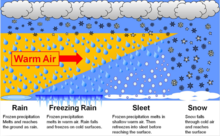
Hi Everybody:
March came in like a lion on the North Wind and covered Rainbow Creek with Ice. The Spring Blooms are frozen in time as ice is falling out of the sky, out of the trees and clinging to everything. Birds are very cold and not singing now. As I walk around to get a few pics of the 'rare event', I hear ice crunching under my boots. I hear branches crashing to the ground from the weight of ice. My fingers are cold and my nose. These are all sensations I do not usually experience in S. Texas. For everybody who does not know about Ice Storms, I have shared info below from Wikipedia. The photostudy (part 1) is also shared below. Enjoy!




https://en.wikipedia.org/wiki/Ice_storm
Ice storm
From Wikipedia, the free encyclopedia
An ice storm is a type of winter storm characterized by freezing rain, also known as aglaze event or, in some parts of the United States, as a silver thaw.[1] The U.S. National Weather Service defines an ice storm as a storm which results in the accumulation of at least 0.25-inch (6.4 mm) of ice on exposed surfaces.[2] From 1982 to 1994, ice storms were more common than blizzards and averaged 16 per year.[3] They are not violent storms, but instead commonly perceived as gentle rains occurring at temperatures just below freezing. For this reason people may be unaware of the danger if it happens overnight.
Formation[edit]
The formation of ice begins with a layer of above-freezing air above a layer of sub-freezing temperatures closer to the surface. Frozen precipitation melts to rain while falling into the warm air layer, and then begins to refreeze in the cold layer below. If the precipitate refreezes while still in the air, it will land on the ground as sleet. Alternatively, the liquid droplets can continue to fall without freezing, passing through the cold air just above the surface. This thin layer of air then cools the rain to a temperature below freezing (0 °C or 32 °F). However, the drops themselves do not freeze, a phenomenon calledsupercooling (or forming "supercooled drops"). When the supercooled drops strike ground or anything else below 0 °C (32 °F) (e.g. power lines, tree branches, aircraft), a layer of ice accumulates as the cold water drips off, forming a slowly thickening film of ice, hence freezing rain.[4][5][6]
While meteorologists can predict when and where an ice storm will occur, some storms still occur with little or no warning.[5] In the United States, most ice storms are in the northeastern part of the country, but damaging storms have occurred farther south. An ice storm in February 1994 resulted in tremendous ice accumulation as far south as Mississippi, and caused reported damage in nine states. More timber was damaged than that caused by Hurricane Camille. An ice storm in eastern Washington in November 1996 directly followed heavy snowfall. The combined weight of the snow and 25 to 37 millimeters (0.98 to 1.46 in) of ice caused widespread damage and was considered the most severe ice storm in the Spokane area since 1940.[3]
Effect[edit]
The freezing rain from an ice storm covers everything with heavy, smooth glaze ice. In addition to hazardous driving or walking conditions, branches or even whole trees may break from the weight of ice. Falling branches can block roads, tear down power and telephone lines, and cause other damage. Even without falling trees and tree branches, the weight of the ice itself can easily snap power lines and also break and bring down power/utility poles; even electricity pylons with steel frames. This can leave people without power for anywhere from several days to a month. According to most meteorologists, just one quarter of an inch of ice accumulation can add about 500 pounds (230 kg) of weight per line span. Damage from ice storms is easily capable of shutting down entire metropolitan areas.
Additionally, the loss of power during ice storms has indirectly caused numerous illnesses and deaths due to unintentional carbon monoxide (CO) poisoning. At lower levels, CO poisoning causes symptoms such as nausea, dizziness, fatigue, and headache, but high levels can cause unconsciousness, heart failure, and death.[7] The relatively high incidence of CO poisoning during ice storms occurs due to the use of alternative methods of heating and cooking during prolonged power outages, common after severe ice storms.[8] Gas generators, charcoal and propane barbecues, and kerosene heaters contribute to CO poisoning when they operate in confined locations.[7] CO is produced when appliances burn fuel without enough oxygen present,[9] such as basements and other indoor locations.
Loss of electricity during ice storms can indirectly lead to hypothermia and even death from hypothermia. It can also lead to ruptured pipes due to water freezing inside the pipes.






Link to photostudy in G+ Albums:
https://plus.google.com/u/0/photos/117645114459863049265/albums/5987031940383914193











...this is brendasue signing off from Rainbow Creek. See You next time!



part 2 next post
O+O




No comments:
Post a Comment
Hi Everybody! Please say hello and follow so I know you are here! Due to the inconsideration of people trying to put commercials on my blog comment area, I have restricted use of anonymous posts. Sorry that some hurt all.
My public email is katescabin@gmail.com No spammers or trolls